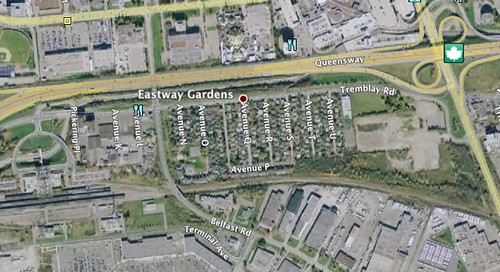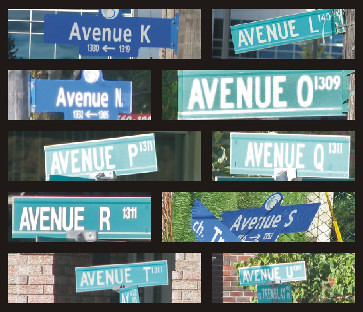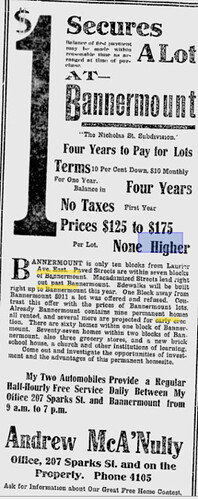
This started out as another one of the “Street Names” stories.
Once my digging began, though, it turned into a story about a neighbourhood that most people in Ottawa can’t place. Its history is little-known.
Where do you find this district? Well, just to the east of the train station, branching off of Tremblay Road, are two sets of side-streets. Uniquely for Ottawa, they are alphabetized.

There is Avenue K and Avenue L, then the interruption of Belfast Road, followed by Avenues N through U.
The omissions will be explained as we go along.
This kind of nomenclature is not unique among Canadian cities. Saskatoon has had such street names since the 1880s. Ottawa’s “alphabet village” came along some two decades later, or so we’re told by the maps we have from those days.
In the beginning, though,the neighbourhood wasn’t even part of Ottawa. That came later. And it has been known by at least three names over the past century.

On September 18, 1911, the former township of Gloucester registered the sub-division of Bannermount. Originally the property of one Nicholas J. Tremblay, it appears that the development was expected to serve as a home to the workers of at least two of the railways then operating in the region, the Montreal & Ottawa and the Ottawa & New York. The development backed onto the Ottawa & New York tracks that crossed the Rideau River just south of Hurdman’s Bridge as it was then known.
The Avenues were alphabetized from the beginning: Avenues A through H, J through U. If the developers had plans for more beyond U there doesn’t appear to be a record of it.
And until that development was registered, the road that these avenues branched off from wasn’t called “Tremblay Road”, but rather Cyrville Road. Apparently, that was the original name of the road. Yet another name change in a city whose history has been filled with them.
After 1912, it was known as Nicholas Street. As it was then in the township of Gloucester, this could be done with no worries about duplicating the name of downtown Ottawa’s better-known Nicholas Street. In the Ottawa Citizen in May of that same year, we can find ads for homes in Bannermount paid for by one Andrew McA’Nulty, with nine already drawing in rental income. Even more amazing: the down payment requested by Mr. McA’Nulty for the lots themselves?

One dollar!
Yet not much ever got built there, despite the railroad work that grew up. The tracks went from their original owners’ hands to the CNR. Gloucester reclaimed many of the lots by 1941 due to tax arrears and tried to re-sell them.
The city of Ottawa eventually expanded across the Rideau River to the east, into the land surrounding Bannermount, annexing it along with the territories north and south of it, and by the 1950s, modest single-family housing finally started going into the eastern end of the subdivision.
About the same time, the neighbourhood was renamed “Eastway Gardens”. The likes of MapArt, Pathfinder Maps, and Google Maps still use that label to this day. Avenues A through D were wiped off the map to make room for the Riverside Drive-Queensway interchange built in 1960. Also in that year Avenue M was replaced by Belfast Road, which connected the industrial park north of the Queensway to the one south of it. More letters disappeared as the new train station forced the removal of Avenues E through H by 1967.
The Urban Neighbourhood Survey of 2008 came up with its own boundaries for the neighbourhoods of the city, of course, and lumped this little collection of side streets in with a bunch of light and medium-industry districts under the moniker of “East Industrial”, a name that hasn’t caught on outside planning circles.
Many of the small apartment buildings and houses built in the district during the 1950s are still there. Others were leveled for one reason or another, or converted to business use. Avenues N through U still have a good concentration of homes though, and there is Cecil Morrison Park with its wading pool, and tennis and basketball courts to serve the people who live there. Transit is not much of an issue with two Transitway stations within walking distance. As for shopping, there is the Train Yards mall built on some of the former CNR yards directly across the rail tracks by way of Belfast Road to the south, and the St. Laurent Mall to the east by way of the footpath leading to the Transitway stop, assuming that you’re not interested in using Route 18 for other local needs. Of course, for inter-city transit, there aren’t many residential districts in all of Ontario that are closer to a mainline train station.
I’ve heard people accuse this neighbourhood of looking “sterile”. Perhaps it is, if you are looking only at Avenues K and L, the two that are west of Belfast Road. That’s where most of the demolitions happened, which opened up gaps that were turned into day-parking for workers at the train station or the office buildings at Pickering Place; used car lots have also done business here over the years.
It might not always be easy on the eyes, but in fact there is a gritty kind of character to the area, and it even has an Ottawa landmark, the well-known White Horse restaurant at Belfast and Tremblay.
And here’s an interesting note to close on: next year, it will be a century since the registration of the original plans for “Bannermount”. Might be time to restore that name to its place of honour?

5 comments
Hi!
That was really interesting. I moved onto Ave. N in 1991 into a little story and a half. All these little houses on Ave.N and O were built for the employees at Morrison Lamoth Bakery ( Jean Pigot’s family) A lot of these former workers were still living here and told stories about working at the bakery, about the Avenues and the changes that were made. The one story homes on most of the avenues were built by a different developer and the two story house on N was actually moved to that location from somewhere on St. Laurent Blvd. These Avenues were all dirt, the 1 1/2 stories all had septic tanks, heated by coal,(our basement still has indications as to where the coal bin was) and had well water (somewhere in our front lawn there is a well). The little white house on the corner had a stone wall that faced out on Ave. N. When the city decided it was time to pave these streets they raised the avenues and actually buried the stone wall. I’m presuming it’s still there under asphalt and dirt.
The neighbours also talked about the little woods that ran between the railway tracks and the avenues. They loved those woods and would take picnics, strolls through them along with picking berries and seeing deer. When I moved in a developer had cleared the land and left it a barren wasteland. I was told that the oldest tree in Ottawa was taken down at that time. We had a coyote at the time who used to trot up the streets looking for the rabbits that had established themselves so well.
A lot of the original owners have passed away but there are a few still around who can still tell a great story of the life they have had in this little oasis.
Anyway, that is what I know about this area. It’s a wonderful little place to live and it’s become quite vibrant with new families with young children moving in as the aging population move out. People know each other along all the avenues and walking down them you always have someone to wave at or chat with. It’s so easy to get anywhere you want to be and by car or even bus less than 10 mins to get downtown. We are squeezed on all sides with light industrial and will be even more so when the huge vacant federal lot (used to be roads department) at the St Laurent end is developed. We are just hoping that what is left of the woods is spared. Where once we were allowed to walk our dogs or play on the big cared for field with beautiful trees is now fenced in and looking like an eyesore.
The park is very busy during the summer and in the winter there is a skating rink where kids big and small go to play hockey after school or just to skate.
Yours sincerely
Lindsay
Thanks for taking the time to research our neighbourhood and posting an interesting story. We will share and make good use of it!
Wow! Thanks for all the historical info! We are about to move to Avenue O and just loved reading about the past life of our new neighbourhood!
Yes, thank you. There seems to be very little information on our neighborhood and it is a great little place to live. I moved in on Avenue P just over a year and half ago and have recently been looking for the history on this neighborhood. I totally enjoyed reading your story. Thanks for doing the research.
Since I am originally from Ottawa, I found this story very interesting. Good job! And thank you Lindsay for your input.